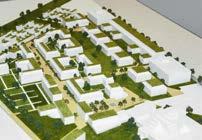
4 minute read
Market Segment: Industrial & Commercial
Demand for commercial space in the Rhine-Neckar Metropolitan Region is estimated to be around 1,500 hectares by 2035. Conversion and expansion of existing industrial estates and inter-municipal cooperation should help to meet this demand while conserving the region’s resources.
Advertisement
The logistics industry is booming. International links between economic areas, production on demand and the constantly growing e-commerce require central locations with multi-modal links. The Rhine-Neckar Metropolitan Region scores highly here with its excellent access to road, rail, water and air transportation services. Mannheim’s main railway station is the second largest distribution hub in Germany. In February 2022, the first services of the new rail freight link between Mannheim and its Chinese twin city Qingdao set off on their 12,300 km journey. The Mannheim/Ludwigshafen port centre is Europe's second-largest inland port and another vital hub for European freight traffic. The nearby Frankfurt Airport also offers the option of transporting time-sensitive goods as air freight.
Demand from companies and logistics providers for commercial space is therefore high in the Rhine-Neckar region. This year’s Real Estate Market Report has selected and analysed 25 industrial parks from the region’s annual municipal survey. The selected sites cover a total area of approx. 5.02 million m², of which 618,000 m² are still undeveloped and available at short notice. Purchase prices for fully accessible industrial land parcels in the urban heart of the region generally range from EUR 150 to EUR 170 per m². In suburban areas, the starting point for negotiations is between EUR 90 and 185 per m², with peaks of up to EUR 200. In the periphery, prices fall to an average of EUR 60 per m² – usually with very good transportation links. Investment activity in the areas of production and logistics, spread across the entire region, will total approx. EUR 240 million over the next few years. Many projects are sold before they are even completed.
For example, LIP Invest acquired a logistics centre in Dannstadt-Schauernheim, Rhineland-Palatinate, for one of its logistics funds as part of a forward funding deal from Panattoni. It is already fully leased to the IFCO Systems Group. Completion of the distribution centre is scheduled for the end of Q3 2022. The plot of land measuring approx. 41,500 m² is being used to create a logistics area covering 23,200 m². DGNB Gold certification is
being sought for the new building. In Landau's D10 industrial park, the PHS Group and its approx. 150 employees are moving into a new company headquarters building. The new four-storey building with staggered floor(s) and a green roof is scheduled for completion in the summer of 2022.
Sustainability certificates also play a significant role in logistics real estate.
The distribution site in Dannstadt-Schauernheim with a green roof and photovoltaic system has approval for 24-hour operation.
With the acquisition of an 83,000 m² brownfield site in Mannheim, Montea gained its first foothold in Germany through its cooperation partner IMPEC Group. The site is leased for 8.5 years. After the lease expires, it will be redeveloped into a sustainable logistics centre. In Rhenaniastrasse in Mannheim-Neckarau, the Weinheim-based Atalanta Group purchased an industrial site with an area of approx. 50,000 m² in two tranches. The plan is to develop multi-functional commercial premises with a variety of uses and logistics areas.
In October 2021, the town of Weinheim opened a new industrial park between the B3 and the railway line. The Gewerbegebiet Nord park comprises 31 municipal plots with a total area of just under 50,000 m². Most of the 15 building plots awarded by the city in September 2021 went to SMEs from the city or surrounding region that need to expand.
Heidelberg and Leimen are working together to develop a joint commercial and industrial area. On 1 January 2021, the two municipal authorities founded a special-purpose association to sustainably upgrade developed and undeveloped areas in the locality in partnership with local businesses and property owners.
The “urban area”
To meet the demographic, climatic and social challenges of the present and future, cities need new structures for living together. Ensuring that user-oriented residential, working, education, shopping and leisure facilities are linked by short travelling distances, should make daily life easier for everyone and conserve resources. To promote the “city of short distances”, a new planning category was created in 2017 – the “urban area” (Section 6a BauNVO). This allows different functions to be located in close proximity to each other, provided they do not significantly interfere with residential life. In an “urban area”, higher and denser construction is allowed and the daytime noise limits are slightly higher than in a “mixed use area” at 63 dB. The maximum site occupancy index is 0.8 and the maximum floor space index is 3.0. The mix of different uses is specifically desired here and there is no requirement to maintain certain ratios as in the mixed-use area. Infrastructure or production areas that are no longer needed but located close to city centres offer good conditions for this type of development. The new type of area is being used in practice in the Rhine-Neckar Metropolitan Region, e. g. in Ludwigshafen. The Heinrich Pesch Siedlung (see image), the first “urban quarter” in the city, is being built on a site covering more than ten hectares. The planned project will create 580 apartments, cultural and social facilities as well as commercial units. All plots of land will be granted on a long-term lease basis. And the “urban area” model is also under discussion for the Speyer industrial yard.




